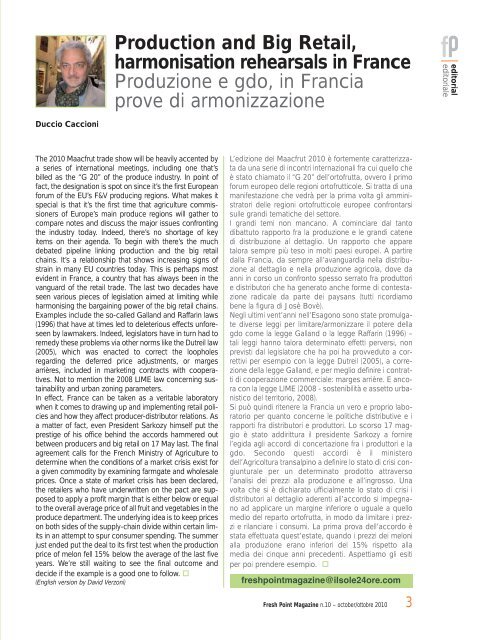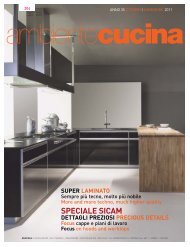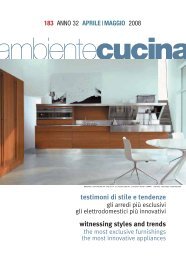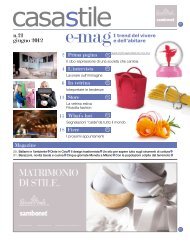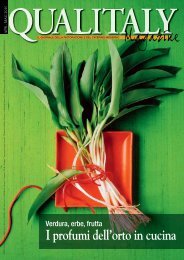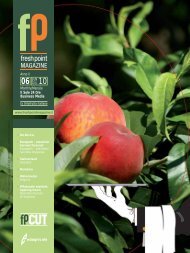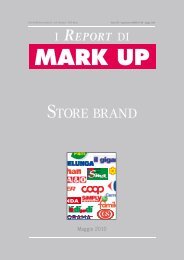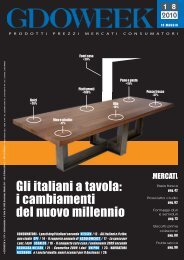Fresh Point Magazine - B2B24 - Il Sole 24 Ore
Fresh Point Magazine - B2B24 - Il Sole 24 Ore
Fresh Point Magazine - B2B24 - Il Sole 24 Ore
Create successful ePaper yourself
Turn your PDF publications into a flip-book with our unique Google optimized e-Paper software.
Duccio Caccioni<br />
Production and Big Retail,<br />
harmonisation rehearsals in France<br />
Produzione e gdo, in Francia<br />
prove di armonizzazione<br />
The 2010 Maacfrut trade show will be heavily accented by<br />
a series of international meetings, including one that’s<br />
billed as the “G 20” of the produce industry. In point of<br />
fact, the designation is spot on since it’s the first European<br />
forum of the EU’s F&V producing regions. What makes it<br />
special is that it’s the first time that agriculture commissioners<br />
of Europe’s main produce regions will gather to<br />
compare notes and discuss the major issues confronting<br />
the industry today. Indeed, there’s no shortage of key<br />
items on their agenda. To begin with there’s the much<br />
debated pipeline linking production and the big retail<br />
chains. It’s a relationship that shows increasing signs of<br />
strain in many EU countries today. This is perhaps most<br />
evident in France, a country that has always been in the<br />
vanguard of the retail trade. The last two decades have<br />
seen various pieces of legislation aimed at limiting while<br />
harmonising the bargaining power of the big retail chains.<br />
Examples include the so-called Galland and Raffarin laws<br />
(1996) that have at times led to deleterious effects unforeseen<br />
by lawmakers. Indeed, legislators have in turn had to<br />
remedy these problems via other norms like the Dutreil law<br />
(2005), which was enacted to correct the loopholes<br />
regarding the deferred price adjustments, or marges<br />
arrières, included in marketing contracts with cooperatives.<br />
Not to mention the 2008 LIME law concerning sustainability<br />
and urban zoning parameters.<br />
In effect, France can be taken as a veritable laboratory<br />
when it comes to drawing up and implementing retail policies<br />
and how they affect producer-distributor relations. As<br />
a matter of fact, even President Sarkozy himself put the<br />
prestige of his office behind the accords hammered out<br />
between producers and big retail on 17 May last. The final<br />
agreement calls for the French Ministry of Agriculture to<br />
determine when the conditions of a market crisis exist for<br />
a given commodity by examining farmgate and wholesale<br />
prices. Once a state of market crisis has been declared,<br />
the retailers who have underwritten on the pact are supposed<br />
to apply a profit margin that is either below or equal<br />
to the overall average price of all fruit and vegetables in the<br />
produce department. The underlying idea is to keep prices<br />
on both sides of the supply-chain divide within certain limits<br />
in an attempt to spur consumer spending. The summer<br />
just ended put the deal to its first test when the production<br />
price of melon fell 15% below the average of the last five<br />
years. We’re still waiting to see the final outcome and<br />
decide if the example is a good one to follow.<br />
(English version by David Verzoni)<br />
L’edizione del Maacfrut 2010 è fortemente caratterizzata<br />
da una serie di incontri internazionali fra cui quello che<br />
è stato chiamato il “G 20” dell’ortofrutta, ovvero il primo<br />
forum europeo delle regioni ortofrutticole. Si tratta di una<br />
manifestazione che vedrà per la prima volta gli amministratori<br />
delle regioni ortofrutticole europee confrontarsi<br />
sulle grandi tematiche del settore.<br />
I grandi temi non mancano. A cominciare dal tanto<br />
dibattuto rapporto fra la produzione e le grandi catene<br />
di distribuzione al dettaglio. Un rapporto che appare<br />
talora sempre più teso in molti paesi europei. A partire<br />
dalla Francia, da sempre all’avanguardia nella distribuzione<br />
al dettaglio e nella produzione agricola, dove da<br />
anni in corso un confronto spesso serrato fra produttori<br />
e distributori che ha generato anche forme di contestazione<br />
radicale da parte dei paysans (tutti ricordiamo<br />
bene la figura di Josè Bovè).<br />
Negli ultimi vent’anni nell’Esagono sono state promulgate<br />
diverse leggi per limitare/armonizzare il potere della<br />
gdo come la legge Galland o la legge Raffarin (1996) –<br />
tali leggi hanno talora determinato effetti perversi, non<br />
previsti dal legislatore che ha poi ha provveduto a correttivi<br />
per esempio con la legge Dutreil (2005), a correzione<br />
della legge Galland, e per meglio definire i contratti<br />
di cooperazione commerciale: marges arrière. E ancora<br />
con la legge LIME (2008 - sostenibilità e assetto urbanistico<br />
del territorio, 2008).<br />
Si può quindi ritenere la Francia un vero e proprio laboratorio<br />
per quanto concerne le politiche distributive e i<br />
rapporti fra distributori e produttori. Lo scorso 17 maggio<br />
è stato addirittura il presidente Sarkozy a fornire<br />
l’egida agli accordi di concertazione fra i produttori e la<br />
gdo. Secondo questi accordi è il ministero<br />
dell’Agricoltura transalpino a definire lo stato di crisi congiunturale<br />
per un determinato prodotto attraverso<br />
l’analisi dei prezzi alla produzione e all’ingrosso. Una<br />
volta che si è dichiarato ufficialmente lo stato di crisi i<br />
distributori al dettaglio aderenti all’accordo si impegnano<br />
ad applicare un margine inferiore o uguale a quello<br />
medio del reparto ortofrutta, in modo da limitare i prezzi<br />
e rilanciare i consumi. La prima prova dell’accordo è<br />
stata effettuata quest’estate, quando i prezzi dei meloni<br />
alla produzione erano inferiori del 15% rispetto alla<br />
media dei cinque anni precedenti. Aspettiamo gli esiti<br />
per poi prendere esempio.<br />
freshpointmagazine@ilsole<strong>24</strong>ore.com<br />
<strong>Fresh</strong> <strong>Point</strong> <strong>Magazine</strong> n.10 – october/ottobre 2010<br />
3<br />
editorial<br />
editoriale


